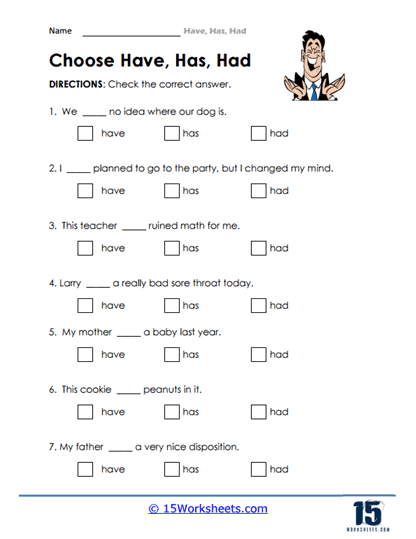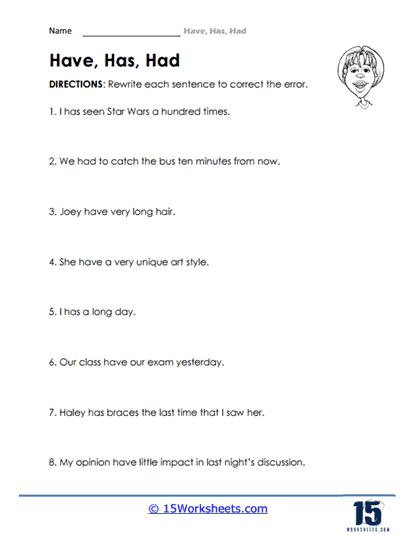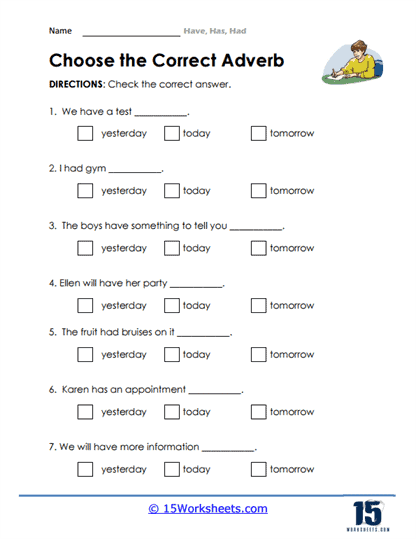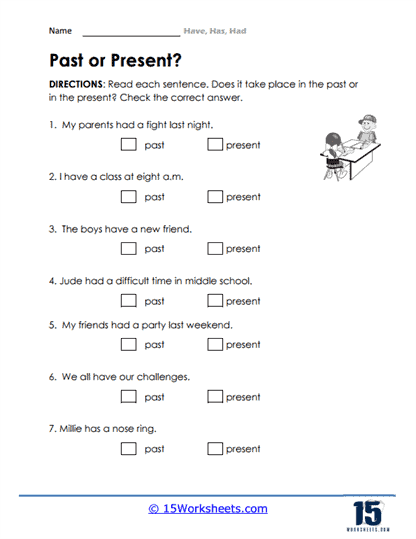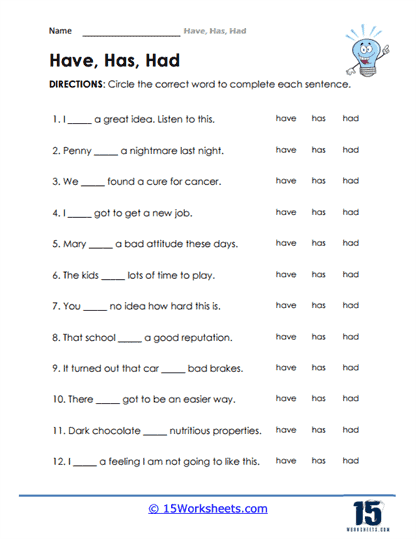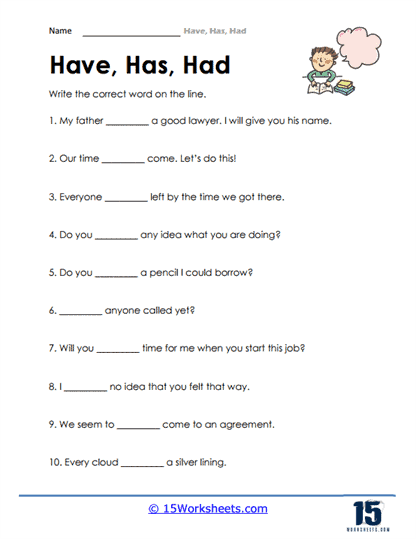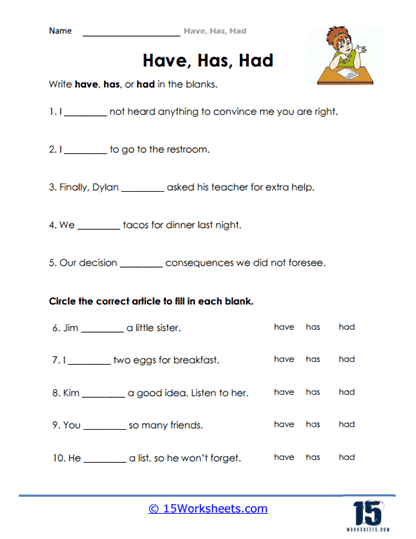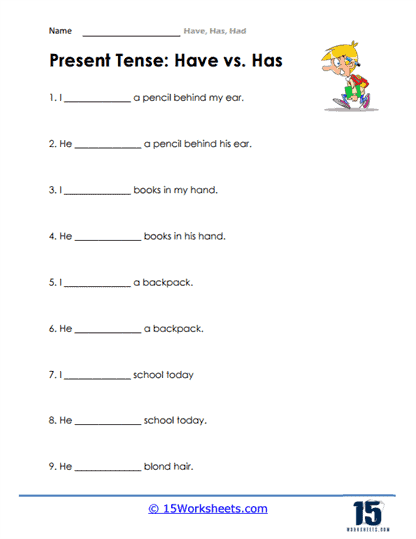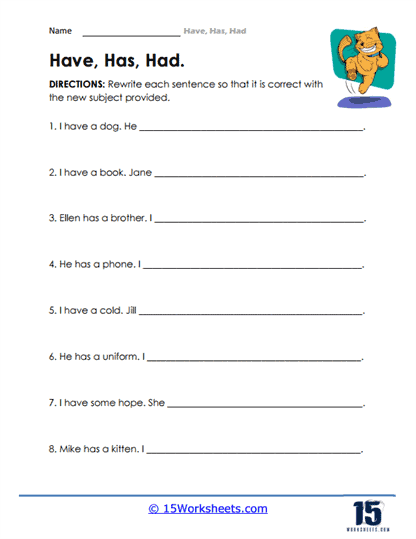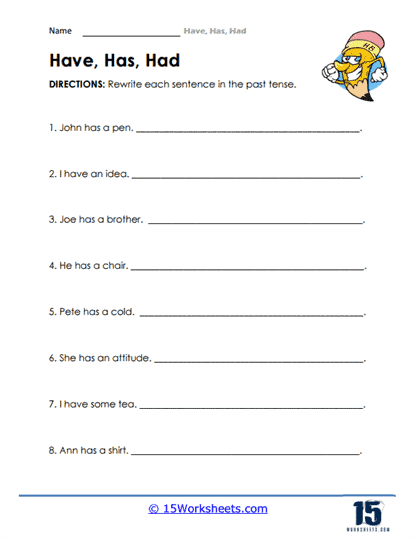Have, Has, Had Worksheets
All About These 15 Worksheets
This collection of worksheets is designed to help students improve their understanding and usage of the English verbs “have,” “has,” and “had.” The worksheets cover various aspects of these verbs, including their meaning, forms, and usage in different contexts. Through a variety of exercises, students will learn how to correctly use “have,” “has,” and “had” in sentences. Through these exercises, students will:
- Complete sentences by supplying the correct “have,” ‘has,” and “had” verb;
- Spot errors when the verbs “have,” “has,” and “had” are used incorrectly and correct them;
- And recognize when the verb used in a sentence is in the past or present form.
By completing these worksheets, students will develop greater confidence and proficiency in using these important verbs in their spoken and written English.
When To Use Have Has or Had
The foundation of speaking and writing English well is centered on our proper usage of grammar. One of the most common grammatical mistakes people make are with their usage of word tense. We use tenses to add an inflectional to our verbs. By inserting the inflectional we relate the timing of event or action that was to take place. Specific variations of verbs are used to pinpoint a time that this event takes place. One of the first instances that students run into this is when they need to place the use of (have, has, or had). In this series of worksheets, we will look at how to use the terms (have, has, or had) to properly align the grammar and context within the sentence.
We use these terms to suggest a form of ownership or accomplishment. The clear distinction between which of these tenses to use starts with determining if the sentence is referring to an event that is presently taking place (present) or has previously taken place (past). If the event is in the present tense, we then look to see if the subject is singular or plural. If it is present tense and singular, we use the term has. If it is present tense and plural, we use the term have. If it is past tense, we use the term had. It is that simple. Take a look at quick way to break the proper tense usage by asking yourself these questions:
- Is this action or event taken place now or in the past?
If, it is in the past, we use the term (had). This applies to any point of view (first, second, or third person).
- If it is in the present, is the subject singular or plural?
If it is singular, we use the term (has). Singular placements are often found with pronouns such as she or he.
If it is plural, we use the term (have). You spot plural placements when the subject contains plural terms such as: they, we, and us.
Do you ever get confused about when to use have has or had? Children who have only recently been introduced to grammar rules are likely to become confused with have has or had. However, adults also frequently make mistakes between these verbs. The best method to avoid confusion with have, has, or had is to learn their meanings and practice using them appropriately. Here is a detailed explanation of have has and had, along with examples of how to use them in your sentences.
Have
Have means to hold, own, or possess something. The present tense of the verb had is have. The statement’s context affects how to use “have” correctly in a sentence. The speaker must use have when using the pronouns we, you, they, and I in the second, first, third and second-person conjugations. Have is mostly used with plural nouns and pronouns. For example:
- I have the best mother.
- They have him in custody.
- They have delivered the package.
- You have a stain on your shirt.
- We have to meet at 1.
Has
Similar to the verb have, has also used in present However, the difference between the two is that has used for the third person singular. In simple words, has is used with she, it, or he. For example:
- He has to work.
- Ron has a fever.
- Sarah has a bubbly personality.
- She has to leave work early.
- Adam has to meet the deadline.
Had
Had is much more different than has or have as it refers to past tense. Moreover, had is used for singular nouns such as she, it, or he. For example:
- He had to leave early.
- I wish I had been there to see you get married.
- I had it in my hand.
- She had a son at an early age.
- She asked me what I had been up to.
How To Practice When To Use Have Had Or Has?
The best way to practice using have has or had is to use these verbs in your day-to-day conversations. Moreover, if you are teaching when to use have has or had to kindergarteners, here are a few written worksheet ideas you can use:
- Create a fill-in-the-blank worksheet with different sentences, including having has or had, and instruct the students to fill the blank with the correct verb. Here is an example, I____ a cat, He___ to shower
- Create a worksheet with different sentences and use the wrong verb in them. For example, I has a dog; He have my number. Now you can instruct students to correct the sentences and use the appropriate verb
- Ask students to write three sentences each for have has or had
- Conduct online quizzes that are targeted towards testing a child’s understanding of when to use have has or had
- Create a worksheet with sentences featuring have has or had. Make sure that you have used these verbs incorrectly in the sentences. Next, give students four choices of verbs that can go into the fill-in-the-blank and instruct them to choose the best choice.






